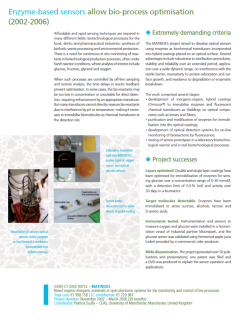 The EU funded MATINOES project developed optical sensors using enzymes as biochemical transducers incorporated into hybrid coatings placed on an optical surface. Desired advantages include robustness to sterilisation procedures, stability and reliability over an extended period, application over a wide dynamic range, no interference with the sterile barrier, insensitivity to protein adsorption and surface growth, and resistance to degradation or enzymatic breakdown.
The EU funded MATINOES project developed optical sensors using enzymes as biochemical transducers incorporated into hybrid coatings placed on an optical surface. Desired advantages include robustness to sterilisation procedures, stability and reliability over an extended period, application over a wide dynamic range, no interference with the sterile barrier, insensitivity to protein adsorption and surface growth, and resistance to degradation or enzymatic breakdown.
The work comprised several stages:
- development of inorganic-organic hybrid coatings (OrmocerR) to immobilise enzymes and fluorescent chemical transducers as claddings on optical components such as lenses and fibres;
- purification and modification of enzymes for immobilisation into the optical coatings;
- development of optical detection systems for on-line monitoring of bioreactions by fluorescence;
- testing of sensor prototypes in a laboratory biotechnological reactor and in real biotechnological processes.
Project successes
- Layers optimised. Double and single layer coatings have been optimised for immobilisation of enzymes for sensing glucose over a concentration range of 0-30 mmol/l, with a detection limit of 0.5 % (vol) and activity over 30 days in a bioreactor.
- Target molecules detectable. Enzymes have been immobilised to sense sucrose, alcohols, lactose and D-amino acids.
- Instruments tested. Instrumentation and sensors to measure oxygen and glucose were installed in a fermentation vessel of industrial partner Moorepark, and the glucose sensor was validated using fermented apple juice (cider) provided by a commercial cider producer.
- Wide dissemination. The project generated over 50 publications and presentations; one patent was filed and a DVD was produced to explain the sensor operation and
- applications.

